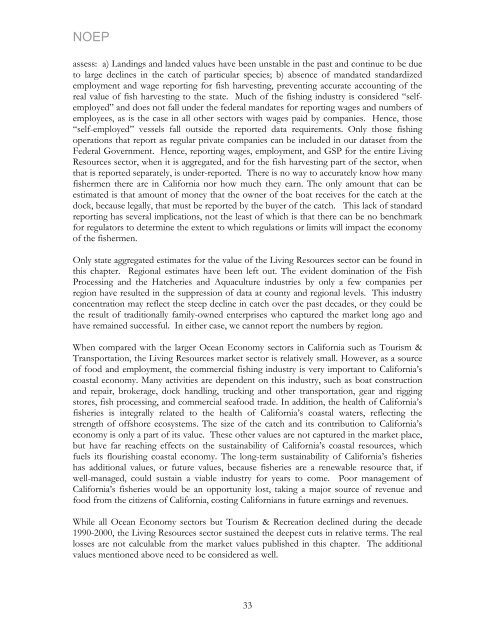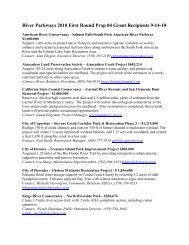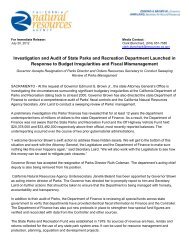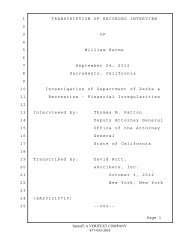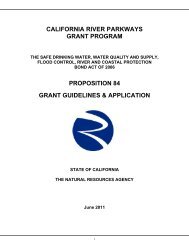California's Ocean Economy - California Resources Agency - State ...
California's Ocean Economy - California Resources Agency - State ...
California's Ocean Economy - California Resources Agency - State ...
Create successful ePaper yourself
Turn your PDF publications into a flip-book with our unique Google optimized e-Paper software.
NOEP<br />
assess: a) Landings and landed values have been unstable in the past and continue to be due<br />
to large declines in the catch of particular species; b) absence of mandated standardized<br />
employment and wage reporting for fish harvesting, preventing accurate accounting of the<br />
real value of fish harvesting to the state. Much of the fishing industry is considered “selfemployed”<br />
and does not fall under the federal mandates for reporting wages and numbers of<br />
employees, as is the case in all other sectors with wages paid by companies. Hence, those<br />
“self-employed” vessels fall outside the reported data requirements. Only those fishing<br />
operations that report as regular private companies can be included in our dataset from the<br />
Federal Government. Hence, reporting wages, employment, and GSP for the entire Living<br />
<strong>Resources</strong> sector, when it is aggregated, and for the fish harvesting part of the sector, when<br />
that is reported separately, is under-reported. There is no way to accurately know how many<br />
fishermen there are in <strong>California</strong> nor how much they earn. The only amount that can be<br />
estimated is that amount of money that the owner of the boat receives for the catch at the<br />
dock, because legally, that must be reported by the buyer of the catch. This lack of standard<br />
reporting has several implications, not the least of which is that there can be no benchmark<br />
for regulators to determine the extent to which regulations or limits will impact the economy<br />
of the fishermen.<br />
Only state aggregated estimates for the value of the Living <strong>Resources</strong> sector can be found in<br />
this chapter. Regional estimates have been left out. The evident domination of the Fish<br />
Processing and the Hatcheries and Aquaculture industries by only a few companies per<br />
region have resulted in the suppression of data at county and regional levels. This industry<br />
concentration may reflect the steep decline in catch over the past decades, or they could be<br />
the result of traditionally family-owned enterprises who captured the market long ago and<br />
have remained successful. In either case, we cannot report the numbers by region.<br />
When compared with the larger <strong>Ocean</strong> <strong>Economy</strong> sectors in <strong>California</strong> such as Tourism &<br />
Transportation, the Living <strong>Resources</strong> market sector is relatively small. However, as a source<br />
of food and employment, the commercial fishing industry is very important to <strong>California</strong>’s<br />
coastal economy. Many activities are dependent on this industry, such as boat construction<br />
and repair, brokerage, dock handling, trucking and other transportation, gear and rigging<br />
stores, fish processing, and commercial seafood trade. In addition, the health of <strong>California</strong>’s<br />
fisheries is integrally related to the health of <strong>California</strong>’s coastal waters, reflecting the<br />
strength of offshore ecosystems. The size of the catch and its contribution to <strong>California</strong>’s<br />
economy is only a part of its value. These other values are not captured in the market place,<br />
but have far reaching effects on the sustainability of <strong>California</strong>’s coastal resources, which<br />
fuels its flourishing coastal economy. The long-term sustainability of <strong>California</strong>’s fisheries<br />
has additional values, or future values, because fisheries are a renewable resource that, if<br />
well-managed, could sustain a viable industry for years to come. Poor management of<br />
<strong>California</strong>’s fisheries would be an opportunity lost, taking a major source of revenue and<br />
food from the citizens of <strong>California</strong>, costing <strong>California</strong>ns in future earnings and revenues.<br />
While all <strong>Ocean</strong> <strong>Economy</strong> sectors but Tourism & Recreation declined during the decade<br />
1990-2000, the Living <strong>Resources</strong> sector sustained the deepest cuts in relative terms. The real<br />
losses are not calculable from the market values published in this chapter. The additional<br />
values mentioned above need to be considered as well.<br />
33


